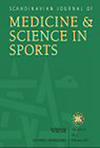竞技跑步者在下体正压跑步机上跑步时的生物力学变化。
IF 3.8
2区 医学
Q1 SPORT SCIENCES
引用次数: 0
摘要
下肢正压跑步机(LBPPTs)为跑步者的损伤康复和表现训练提供精确的体重卸载。本研究调查了竞技跑步者在不同体重支持(BWS)水平(0%-80%)下跑步时的生物力学变化,包括性别特异性反应。参赛选手26名(年龄:33.6±9.8岁;15名女性,11名男性)在9个BWS级别以12公里/小时的速度随机完成了3分钟的跑步。利用放置在胫骨和足部的压力鞋垫和惯性传感器测量时空参数、足底力、胫骨峰值加速度和运行稳定性。我们的研究结果显示,随着BWS的增加,步速(b = -0.24步•分钟-1/%BWS, p < 0.001)、标准化地面接触时间(b = -0.001 /%BWS, p < 0.001)、足底最大力(b = -0.010 BW/%BWS, p < 0.001)和胫骨峰值加速度(b = -0.03 g/%BWS, p < 0.001)显著降低。摇摆时间增加(b = 1.50 ms/%BWS, p < 0.001),站立时间减少(b = -0.41 ms/%BWS, p < 0.001)。运行稳定性有微小变化(足部:b = -0.001 /%BWS, p = 0.017;胫骨:b = 0.001 /%BWS, p = 0.009)。在步率(b = -6.79步•min-1, p = 0.045)和最大足底力(b = -0.128 BW, p = 0.034)方面存在性别差异,但性别与BWS的交互作用均不显著。这项研究的结果强调了LBPPTs在减少肌肉骨骼负荷方面的有效性,同时揭示了相关的步态变化。运动员、治疗师和教练应该考虑个体的生物力学反应,以优化康复和表现策略。未来的研究应该探索长期适应和伤害预防的结果。本文章由计算机程序翻译,如有差异,请以英文原文为准。
Biomechanical Changes During Running on a Lower Body Positive Pressure Treadmill in Competitive Runners.
Lower body positive pressure treadmills (LBPPTs) offer precise body weight unloading for injury rehabilitation and performance training in runners. This study investigated biomechanical changes during running at varying body weight support (BWS) levels (0%-80%) in competitive runners, including sex-specific responses. Twenty-six runners (age: 33.6 ± 9.8 years; 15 female, 11 male) completed randomized 3-min running bouts at 12 km/h across nine BWS levels. Spatiotemporal parameters, plantar force, peak tibial acceleration, and running stability were measured using pressure insoles and inertial sensors placed at the tibia and foot. Our results revealed significant reductions in step rate (b = -0.24 steps•min-1/%BWS, p < 0.001), normalized ground contact time (b = -0.001 1/%BWS, p < 0.001), maximum plantar force (b = -0.010 BW/%BWS, p < 0.001), and peak tibial acceleration (b = -0.03 g/%BWS, p < 0.001) with increased BWS. Swing time increased (b = 1.50 ms/%BWS, p < 0.001), while stance time decreased (b = -0.41 ms/%BWS, p < 0.001). Running stability showed marginal changes (foot: b = -0.001 1/%BWS, p = 0.017; tibia: b = 0.001 1/%BWS, p = 0.009). Sex differences were observed in step rate (b = -6.79 steps•min-1, p = 0.045) and maximum plantar force (b = -0.128 BW, p = 0.034), but there were no significant sex × BWS interaction effects for any of the investigated parameters. Findings from this study highlight the effectiveness of LBPPTs for reducing musculoskeletal loading while revealing associated gait changes. Athletes, therapists, and coaches should consider individual biomechanical responses to optimize rehabilitation and performance strategies. Future research should explore long-term adaptations and injury prevention outcomes.
求助全文
通过发布文献求助,成功后即可免费获取论文全文。
去求助
来源期刊
CiteScore
7.90
自引率
4.90%
发文量
162
审稿时长
3 months
期刊介绍:
The Scandinavian Journal of Medicine & Science in Sports is a multidisciplinary journal published 12 times per year under the auspices of the Scandinavian Foundation of Medicine and Science in Sports.
It aims to publish high quality and impactful articles in the fields of orthopaedics, rehabilitation and sports medicine, exercise physiology and biochemistry, biomechanics and motor control, health and disease relating to sport, exercise and physical activity, as well as on the social and behavioural aspects of sport and exercise.

 求助内容:
求助内容: 应助结果提醒方式:
应助结果提醒方式:


